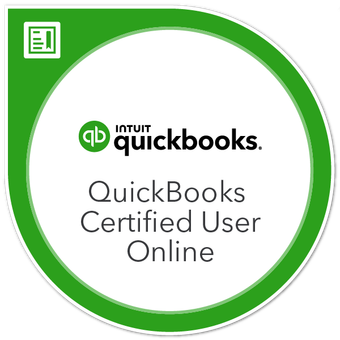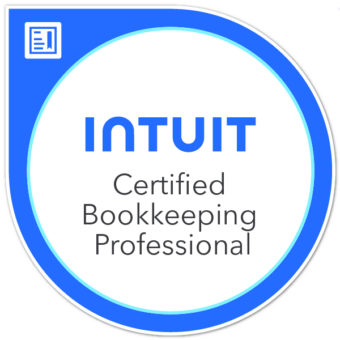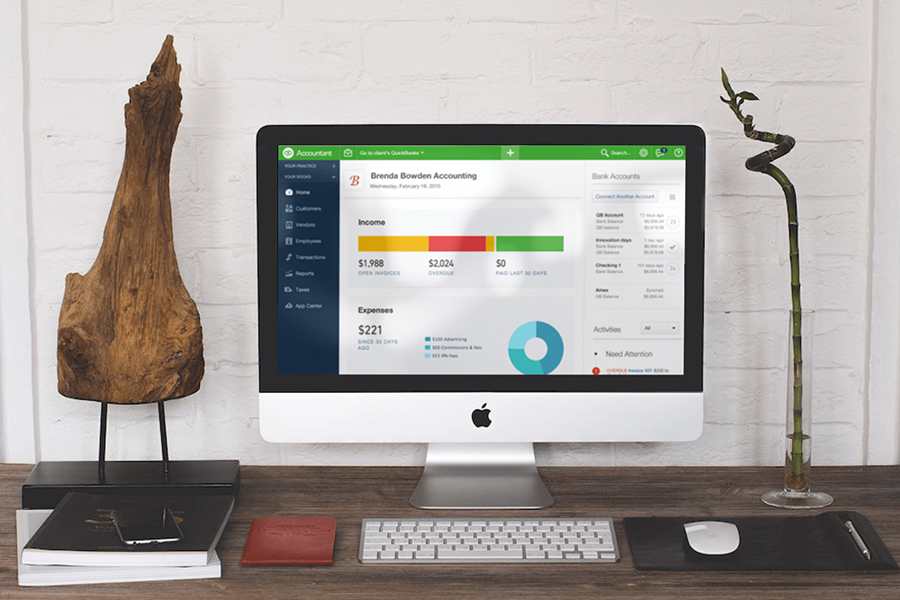We’ll break down everything you need to know about how to become a QuickBooks Certified User (QBCU), from deciding which of the two end-user certifications you want to obtain (you can also choose both) to taking the exam. We also go over their advantages, as becoming a QBCU can open doors to new career opportunities and give you an edge in the competitive job market, whether you’re an accounting professional, a business owner, or simply looking to enhance your skill set.
Step 1: Decide Which End-user Certification You Want to Earn
Certiport has partnered with Intuit to create two certifications that enable you to validate your skills and show potential employers that you have the tools to be successful in your career: QuickBooks Certified User Online or Intuit Certified Bookkeeping Professional. Or, you could choose to obtain both, which provide you with a foundation in bookkeeping principles and hands-on experience with QuickBooks Online.
It is also worth noting that the American Council on Education has successfully evaluated both certifications for college credit. They are each recommended for a total of 3 college credits. Of course, colleges will have the final say as to whether they will award you credit for either of these classes.


Digital badges that can be displayed on your website upon certification
QuickBooks Certified User Online
The QBCU Online certification focuses on validating skills in using QuickBooks Online Plus. It’s designed for students and individuals who want to demonstrate proficiency in QuickBooks Online for accounting, finance, or entrepreneurial endeavors. You’ll focus on bookkeeping activities like tracking expenses, managing invoices, reconciling bank accounts, and generating reports.
The exam will test for the following:
- QuickBooks Online Administration: You’ll learn how to set up and manage QuickBooks Online and manage lists, recurring transactions, and journal entries. This section will also address connecting QuickBooks Online to other apps to help streamline your accounting tasks.
- Sales and Money-in: This covers setting up customers, products, and services; managing sales settings; and recording basic money-in transactions, including payments and deposits.
- Vendors and Money-out: Managing vendor records and expense settings, and recording and managing basic money-out transactions like checks and bill payments are covered in this section.
- Bank Accounts, Transaction Rules, and Receipts: You’ll learn about monitoring bank feeds, implementing financial account connections, and managing receipts—including methods on how to upload them.
- Basic Reports and Views: You’ll be asked to describe the content and purpose of reports, customize and deliver standard reports, and access other reports and views.
Intuit Certified Bookkeeping Professional
This certification is another offering from Intuit, designed to validate essential bookkeeping knowledge and skills. It covers core bookkeeping concepts, including accounting basics, asset and liability accounting, reconciliation, and financial statements. It also goes over accounting for assets and sales transactions and accounting for liabilities, equity, and purchase transactions.
- Accounting Basics: In this section, you’ll learn to define accounting and the concepts underlying accounting measurement. The double-entry accounting method, fundamental concepts of the accounting cycle, and basic accounting principles will also be addressed.
- Accounting for Assets and Sales Transactions: A summary of assets and sales transactions is covered in this section, as well as describing the importance of merchandise inventory and defining depreciation concepts and terminology. Describing the effect of asset and sales transactions on the accounting equation is another topic in this section.
- Accounting for Liabilities, Equity, and Purchase Transactions: A summary of liabilities and purchase transactions will be provided, along with basic payroll transactions and different types of equity. You’ll be able to describe the effect of liability, equity, and purchase transactions on the accounting equation.
- Reconciliation and Financial Statements: The purpose and process of account reconciliations will be covered, along with basic financial statement analytical methods.
Step 2: Sign Up for a Live Class or Complete Training
Visit QuickBooks Training to choose from a live class or complete training, which comes with live help. After you sign up, you’ll be sent a confirmation email that contains valuable information, including instructions for how to log into your account and access classes or other resources. You’ll be able to start taking self-paced classes immediately, search the calendar for live events, and get in touch with knowledgeable QuickBooks instructors with QuickBooks Live Help.
Live 2-day Class
The live class is an intensive learning environment that is conducted online with two full days of instructor-led training. The training is also hands-on; the instructor will share their screen and use QuickBooks to guide you through everything you need to use the software. You have the option of working along with them, but it’s usually best to observe them and the lessons they present.
Classes are offered weekly on Wednesdays and Thursdays from 9:30 a.m. to 5:30 p.m. Central Time, which includes an hour for lunch and two 10-minute breaks. The cost is $779.95, and it includes 275 pages of learning materials along with prep materials and practice exams. For multiple students enrolling, there is a savings of $250 per attendee. You’re also eligible to take the certification exam for free.
Training and Live Help
The complete training and live help option is a much more extensive offering that includes hands-on help with QuickBooks instructors via Zoom, access to classes on a set schedule, and over 60 self-paced courses that you can learn at your own pace and on your own schedule.
Signing up for complete training gives you lifetime access to these self-paced courses—even if you cancel your membership. You’ll also be given credentials for a custom learning portal, where you’ll be able to view your learning options.
The cost for complete training and live help is $999.95, plus $39.95 per month. You have two weeks to complete the instructor-led classes. You also get access to QuickBooks help via QuickBooks Live Help for 10 hours each business day via Zoom. And unlike the live 2-day class, you’ll be able to take practice exams for both the QuickBooks Certified User and Intuit Bookkeeping Professional certifications. You can take the certification exam for free with this option as well.
Step 3: Prepare for the Certification Exam
Prepare for the exam by reviewing the self-paced courses and taking the interactive practice exams. Also, ensure that you’re well-versed with all of the bookkeeping and accounting concepts covered in your materials, and don’t hesitate to contact the instructors with any questions that may come up along the way.
Step 4: Take the Exam
The exam is offered online and is 50 minutes in duration. Depending on which certification you are testing for, there are either 37 or 40 questions, and the cost of the exam is $130 if you don’t enroll with QuickBooks Training. It can be purchased by visiting Certiport and includes one retake code in case you don’t pass the exam the first time.
QuickBooks Certified User Online | Intuit Certified Bookkeeping Professional | |
|---|---|---|
Number of Questions | 37 | 40 |
Length of Time | 50 minutes | 50 minutes |
Type of Questions | Multiple-choice, matching, and true/false | Multiple-choice, matching, true/false, and fill-in-the-blank |
$130 + sitting fee (if applicable) | $130 + sitting fee (if applicable) | |
Included with Exam | One retake code if you don’t pass the exam | One retake code if you don’t pass the exam |
Exam Location | Online | Online |
Step 5: Receive Your Certification
Once you pass the exam, your name and exam results are sent to Intuit by Certiport, the worldwide test administrators. Your exam data is entered into Intuit’s database, and within two weeks, you’ll be sent an email notification of your official digital certificate posted on your Certiport transcript.
It will contain either the QuickBooks Certified User or Intuit Certified Bookkeeping Professional logo that highlights your accomplishment. You are free to display these logos on any marketing materials, including your website.
Benefits of Becoming a QuickBooks Certified User
Becoming a QBCU is a worthwhile investment if you’re seeking to advance your career in accounting, bookkeeping, or any field that involves financial management. It’s a testament to your skills and dedication and can open doors to new opportunities and higher earning potential.
- Enhanced job prospects: A QuickBooks certification sets you apart from other applicants, demonstrating your proficiency in a popular accounting software. Many employers specifically seek candidates with QuickBooks expertise, opening doors to a wider range of job opportunities.
- Career advancement: QuickBooks certification often correlates with higher earning potential, as it signals your value to employers. Also, mastering QuickBooks boosts your confidence in accounting and bookkeeping tasks, leading to better performance and potential promotions.
- Skill development: Certification validates your QuickBooks skills, proving you can efficiently manage financial tasks for businesses. It is a recognized credential in the accounting and bookkeeping fields, enhancing your professional reputation.
- Continued learning: The certification program offers resources for staying up-to-date on QuickBooks features and best practices.
Frequently Asked Questions (FAQs)
You have the option of a live two-day class for $779.95 or a complete training of instructor-led classes over two weeks, plus live help for $999.95. The latter includes training and preparation for all three QuickBooks end-user certifications.
It is a timed exam with either 37 or 40 questions, depending on the certification, and you have 50 minutes to complete it.
There are two types of certification to value your knowledge of QuickBooks and skills. The Certified QuickBooks User exam serves as proof that you know how to use QuickBooks Online for a business, while the Certified Bookkeeping Professional exam evaluates your bookkeeping and accounting skills beyond QuickBooks.
No, you just need an internet connection. You can view the training on any device at any time, as long as you are connected to the internet.
Bottom Line
The QuickBooks Certified User designation is a powerful asset for professionals seeking to demonstrate proficiency in QuickBooks Online, whereas the Intuit Certified Bookkeeping Professional designation illustrates your competency in performing bookkeeping and accounting tasks within the software. By attaining one or both of these credentials, you’ll not only validate your skills but also gain a competitive edge in the job market.


